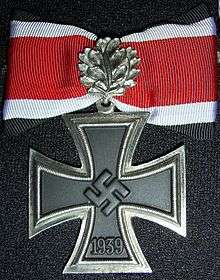Eugen Meindl
| Eugen Meindl | |
|---|---|
 Eugen Meindl | |
| Born |
16 July 1892 Donaueschingen, Grand Duchy of Baden, German Empire |
| Died |
24 January 1951 (aged 58) Munich, Bavaria, West Germany |
| Allegiance |
|
| Service/branch |
|
| Years of service | 1912–1945 |
| Rank | General der Fallschirmtruppe |
| Commands held | 2nd Parachute Corps |
| Battles/wars |
|
| Awards | Knight's Cross of the Iron Cross with Oak Leaves |
Eugen Meindl (16 July 1892 – 24 January 1951) was a German paratroop general during World War II. He was also a recipient of the Knight's Cross of the Iron Cross with Oak Leaves, one of 860 German military men to be so decorated.
Career
Born in 1892, Eugen Meindl enlisted in the army in 1912 and served during World War I. Meindl served with various artillery units in the Reichswehr, the post-war armed forces of the Weimar Republic, and subsequently in the Wehrmacht of Nazi Germany. In November 1939, Meindl was named commander of the 112th Mountain Artillery Regiment in Graz. Promoted to Oberst, he led the “Meindl Group” and made his very first parachute jump at Narvik. He transferred to the Luftwaffe in November 1940.
During the airborne invasion of Crete, Meindl jumped near the Platanias Bridge, where he was seriously wounded. In February 1942, Meindl, now a Generalmajor, became commander of the newly formed Luftwaffe Division Meindl in the Soviet Union. In September he took over the 13th Air Corps (later I Luftwaffe Field Corps). Meindl was named in the Wehrmachtbericht and in 1943 was promoted to commanding general of the 2nd Parachute Corps, which he led in the west on the invasion front and later at Cleves and in the Reichswald. Meindl’s corps fought at Goch and in the Wesel bridgehead, where the unit surrendered. Meindl died in 1951.
Awards
- Iron Cross (1914) 1st Class (17 January 1916) and 2nd Class (18 July 1915)[1]
- Clasp to the Iron Cross (1939) 1st Class (10 June 1940) and 2nd Class (22 October 1939)[1]
- Narvik Shield (10 November 1940)[2]
- Wound Badge (1939) in Black (25 October 1941)[2]
- Eastern Front Medal (9 August 1942)[2]
- "Kreta" Cuffband (25 May 1943)[2]
- German Cross in Gold on 27 July 1942 as Generalmajor in the Luftwaffen-Division "Meindl"[3]
- Knight's Cross of the Iron Cross with Oak Leaves and Swords
- Knight's Cross on 14 June 1941 as Generalmajor and commander Fallschirmjäger-Sturm-Regiment[4]
- 564th Oak Leaves on 31 August 1944 as General der Fallschirmtruppe and commanding general of the II. Fallschirmkorps[4]
Nomination for Swords to Knight's Cross
In April 1945, Meindl was nominated for Swords to the Knight's Cross; the nomination by the troop was approved by each of his commanding officers. However the nomination contains no final remark on the proceedings. Oberst Nicolaus von Below, Hitler's Luftwaffe adjutant, had sent a teleprinter message to the commanding general of the Fallschirmarmee Generaloberst Kurt Student, requesting a statement for this nomination. The copy of the teleprinter contains a note: resubmission "23 April 1945". It seems that the statement was never returned. The paperwork was not finalized by the end of the war. The Association of Knight's Cross Recipients (AKCR) claims that the award was presented in accordance with the Dönitz-decree. This is illegal according to the Deutsche Dienststelle (WASt) and lacks legal justification. Fellgiebel assigned the presentation date.[5]
Meindl is mentioned on a list of the Oberbefehlshaber Nordwest for "Nominations and Bestowal of War Awards" from May 1945. This list, which was intended to be presented to Karl Dönitz, contained twelve names of pending nominations which had been submitted via the chain of command. Dönitz has never signed this list, most likely he has never even seen this list. The responsible personnel offices awarded or declined eight nominations from this list by the end of the war by, two remained unprocessed by the Heerespersonalamt (HPA—Army Personnel Office) and Luftwaffenpersonalamt (LPA — Luftwaffe Personnel Office) and two further were left ready for signing at the Oberkommando der Wehrmacht/Wehrmacht-Führungsstab (OKW/WFSt—leadership staff of the Army High Command).[5]
References
Citations
Bibliography
- Patzwall, Klaus D.; Scherzer, Veit (2001). Das Deutsche Kreuz 1941 – 1945 Geschichte und Inhaber Band II [The German Cross 1941 – 1945 History and Recipients Volume 2] (in German). Norderstedt, Germany: Verlag Klaus D. Patzwall. ISBN 978-3-931533-45-8.
- Scherzer, Veit (2007). Die Ritterkreuzträger 1939–1945 Die Inhaber des Ritterkreuzes des Eisernen Kreuzes 1939 von Heer, Luftwaffe, Kriegsmarine, Waffen-SS, Volkssturm sowie mit Deutschland verbündeter Streitkräfte nach den Unterlagen des Bundesarchives [The Knight's Cross Bearers 1939–1945 The Holders of the Knight's Cross of the Iron Cross 1939 by Army, Air Force, Navy, Waffen-SS, Volkssturm and Allied Forces with Germany According to the Documents of the Federal Archives] (in German). Jena, Germany: Scherzers Militaer-Verlag. ISBN 978-3-938845-17-2.
- Thomas, Franz (1998). Die Eichenlaubträger 1939–1945 Band 2: L–Z [The Oak Leaves Bearers 1939–1945 Volume 2: L–Z] (in German). Osnabrück, Germany: Biblio-Verlag. ISBN 978-3-7648-2300-9.
- Die Wehrmachtberichte 1939–1945 Band 1, 1. September 1939 bis 31. Dezember 1941 [The Wehrmacht Reports 1939–1945 Volume 1, 1 September 1939 to 31 December 1941] (in German). München, Germany: Deutscher Taschenbuch Verlag GmbH & Co. KG. 1985. ISBN 978-3-423-05944-2.
| Military offices | ||
|---|---|---|
| Preceded by Oberst Walter Koch |
Commander of Luftlande-Sturm-Regiment 1 1 September 1940 – 21 May 1941 |
Succeeded by Oberst Hermann-Bernhard Ramcke |
| Preceded by Oberst Hermann-Bernhard Ramcke |
Commander of Luftlande-Sturm-Regiment 1 19 June 1941 – 26 February 1942 |
Succeeded by Luftwaffen-Division Meindl |

